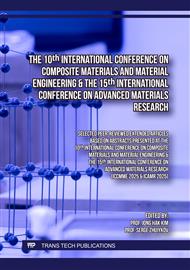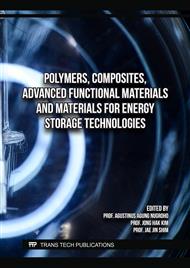[1]
Y. Chen, Y. Kang, Y. Zhao, L. Wang, J. Liu, Y. Li, Z. Liang, X. He, X. Li, N. Tavajohi, B. Li, A review of lithium-ion battery safety concerns: The issues, strategies, and testing standards, J. Energy Chem. 59 (2021) 83–99.
DOI: 10.1016/j.jechem.2020.10.017
Google Scholar
[2]
EUROCAE, Guidance On Determining Failure Modes In Lithium-Ion Cells For Evtol Applications, 2023.
Google Scholar
[3]
W.Q. Walker, J.J. Darst, D.P. Finegan, G.A. Bayles, K.L. Johnson, E.C. Darcy, S.L. Rickman, Decoupling of heat generated from ejected and non-ejected contents of 18650-format lithium-ion cells using statistical methods, J. Power Sources. 415 (2019) 207–218.
DOI: 10.1016/j.jpowsour.2018.10.099
Google Scholar
[4]
A. Nummy, Introduction of a Battery Enclosure Thermal Runaway Material Screening Program for Electric Vehicles: Background and Requirements, 2021.
Google Scholar
[5]
C.C. Höhne, V. Gettwert, F. Frank, S. Kilian, A. Menrath, Bench-scale fuel fire test for materials of rechargeable energy storage system housings, J. Therm. Anal. Calorim. 148 (2023) 305–313.
DOI: 10.1007/s10973-022-11725-6
Google Scholar
[6]
UL, UL 2596 Test Method for Thermal and Mechanical Performance of Battery Enclosure Materials, 2022.
Google Scholar
[7]
J.G. Quintiere, On a method to mitigate thermal runaway and propagation in packages of lithium ion batteries, Fire Saf. J. 130 (2022).
DOI: 10.1016/j.firesaf.2022.103573
Google Scholar
[8]
A.P. Mouritz, Fire resistance of aircraft composite laminates, J. Mater. Sci. Lett. 22 (2003) 1507–1509.
Google Scholar
[9]
A.P. Mouritz, Fire Safety of Advanced Composites for Aircraft, Australian Transport Safety Bureau Research and Analysis Report, 2006.
Google Scholar
[10]
J. Sterling, L. Tattersall, N. Bamber, F. De Cola, A. Murphy, S.L.J. Millen, Composite structure failure analysis post Lithium-Ion battery fire, Eng. Fail. Anal. 160 (2024) 108163.
DOI: 10.1016/j.engfailanal.2024.108163
Google Scholar
[11]
B.K. Kandola, A.R. Horrocks, M.R. Rashid, Effect Of Reinforcing Element On Burning Behaviour Of Fibre-Reinforced Epoxy Composites, 2006.
Google Scholar
[12]
Y.M. Ghazzawi, A.F. Osorio, M.T. Heitzmann, The effect of fibre length and fibre type on the fire performance of thermoplastic composites: The behaviour of polycarbonate as an example of a charring matrix, Constr. Build. Mater. 234 (2020).
DOI: 10.1016/j.conbuildmat.2019.117889
Google Scholar
[13]
Z. Kovács, A. Toldy, Synergistic flame retardant coatings for carbon fibre-reinforced polyamide 6 composites based on expandable graphite, red phosphorus, and magnesium oxide, Polym. Degrad. Stab. 222 (2024).
DOI: 10.1016/j.polymdegradstab.2024.110696
Google Scholar
[14]
M. Has, A. Erdem, L.A. Savas, U. Tayfun, M. Dogan, The influence of expandable graphite on the thermal, flame retardant and mechanical characteristics of short carbon fiber reinforced polyamide composites, J. Thermoplast. Compos. Mater. 36 (2023) 2777–2788.
DOI: 10.1177/08927057221096656
Google Scholar
[15]
R.E. Lyon, P.N. Balaguru, A. Foden, U. Sorathia, J. Davidovits, M. Davidovics, Fire-resistant aluminosilicate composites, Fire Mater. 21 (1997) 67–73. https://doi.org/10.1002/(SICI)1099-1018(199703)21:2<67::AID-FAM596>3.0.CO;2-N.
DOI: 10.1002/(sici)1099-1018(199703)21:2<67::aid-fam596>3.3.co;2-e
Google Scholar
[16]
M. Spontón, J.C. Ronda, M. Galià, V. Cádiz, Cone calorimetry studies of benzoxazine-epoxy systems flame retarded by chemically bonded phosphorus or silicon, Polym. Degrad. Stab. 94 (2009) 102–106.
DOI: 10.1016/j.polymdegradstab.2008.10.005
Google Scholar
[17]
Z. Eslami, F. Yazdani, M.A. Mirzapour, Thermal and mechanical properties of phenolic-based composites reinforced by carbon fibres and multiwall carbon nanotubes, Compos. Part A Appl. Sci. Manuf. 72 (2015) 22–31.
DOI: 10.1016/j.compositesa.2015.01.015
Google Scholar
[18]
P. Patel, T.R. Hull, R.E. Lyon, S.I. Stoliarov, R.N. Walters, S. Crowley, N. Safronava, Investigation of the thermal decomposition and flammability of PEEK and its carbon and glass-fibre composites, Polym. Degrad. Stab. 96 (2011) 12–22.
DOI: 10.1016/j.polymdegradstab.2010.11.009
Google Scholar
[19]
Y. Carpier, B. Vieille, N. Delpouve, E. Dargent, Isothermal and anisothermal decomposition of carbon fibres polyphenylene sulfide composites for fire behavior analysis, Fire Saf. J. 109 (2019).
DOI: 10.1016/j.firesaf.2019.102868
Google Scholar



